Options to Support Sustainable Trajectories in a Rural Landscape: Drivers, Rural Processes, and Local Perceptions in a Colombian Coffee-Growing Region
Abstract
1. Introduction
2. Methods
2.1. Study Area
2.1.1. Description of the Study Area
2.1.2. A Brief History of Coffee Production in the Region
2.2. Data Collection and Analysis
2.2.1. Dynamics of Rural Processes and Their Drivers
2.2.2. Land Use and Coffee Farming in Guayabal de Síquima
2.2.3. Rural Processes and Local Options
3. Results
3.1. Rural Processes and Drivers
3.2. Land Use in Guayabal de Síquima
3.3. Coffee Farming in Guayabal de Síquima: Agricultural Census Data
3.4. Coffee Farming in Guayabal de Síquima: Interviews with Farmers
3.5. Current Rural Processes: Perceptions and Opportunities for Local Actors
4. Discussion
4.1. Dynamics of Rural Processes
4.2. Main Dynamics of Small-Scale Coffee Farmers
4.3. Potential Options to Improve Current Trajectories
5. Conclusions
Author Contributions
Funding
Institutional Review Board Statement
Informed Consent Statement
Data Availability Statement
Acknowledgments
Conflicts of Interest
References
- Guimarães, R.P. Desarrollo Sustentable: ¿Todavía Esperando a Godot? Terra 2015, 1, 67–98. [Google Scholar]
- Ayram, C.A.C.; Etter, A.; Díaz-Timoté, J.; Buriticá, S.R.; Ramírez, W.; Corzo, G. Spatiotemporal evaluation of the human footprint in Colombia: Four decades of anthropic impact in highly biodiverse ecosystems. Ecol. Indic. 2020, 117, 106630. [Google Scholar] [CrossRef]
- Grau, H.R.; Aide, M. Globalization and land-use transitions in Latin America. Ecol. Soc. 2008, 13, 16. [Google Scholar] [CrossRef]
- Boillat, S.; Scarpa, F.M.; Robson, J.P.; Gasparri, N.I.; Aide, T.M.; Aguiar, A.P.; Anderson, L.O.; Batistella, M.; Fonseca, M.; Futemma, C.; et al. Land system science in Latin America: Challenges and perspectives. Curr. Opin. Environ. Sustain. 2017, 26, 37–46. [Google Scholar] [CrossRef]
- Carr, D.L.; Lopez, A.C.; Bilsborrow, R.E. The population, agriculture, and environment nexus in Latin America: Country-level evidence from the latter half of the twentieth century. Popul. Environ. 2009, 30, 222–246. [Google Scholar] [CrossRef]
- Ribeiro Palacios, M.; Huber-Sannwald, E.; García Barrios, L.; Peña de Paz, F.; Carrera Hernández, J.; de Guadelupe Galindo Mendoza, M. Landscape diversity in a rural territory: Emerging land use mosaics coupled to livelihood diversification. Land Use Policy 2013, 30, 814–824. [Google Scholar] [CrossRef]
- Zimmerer, K.S.; Lambin, E.F.; Vanek, S.J. Smallholder telecoupling and potential sustainability. Ecol. Soc. 2018, 23, 30. [Google Scholar] [CrossRef]
- Rice, R.A. A place unbecoming: The coffee farm of northern Latin America. Geogr. Rev. 1999, 89, 554–579. [Google Scholar] [CrossRef] [PubMed]
- Berdegué, P.J.A.; Bebbington, A.; Escobal, J.; Favareto, A.; Fernández, M.I.; Ospina, P. Territorios en Movimiento Dinámicas Territoriales Rurales en América Latina (Territories in Movement Rural Territorial Dynamics in Latin America); Working Paper 110; Programa Dinámicas Territoriales Rurales-Rimisp: Santiago, Chile, 2012. [Google Scholar]
- Dobbs, C.; Escobedo, F.J.; Clerici, N.; de la Barrera, F.; Eleuterio, A.A.; MacGregor-Fors, I.; Reyes-Paecke, S.; Vásquez, A.; Camaño, J.D.Z.; Hernández, H.J. Urban ecosystem Services in Latin America: Mismatch between global concepts and regional realities? Urban Ecosyst. 2019, 22, 173–187. [Google Scholar] [CrossRef]
- Pauchard, A.; Barbosa, O. Regional assessment of Latin America: Rapid urban development and social economic inequity threaten biodiversity hotspots. In Urbanization, Biodiversity and Ecosystem Services: Challenges and Opportunities; Springer: Dordrecht, The Netherlands, 2013; pp. 589–608. [Google Scholar]
- Harvey, C.A.; Pritts, A.A.; Zwetsloot, M.J.; Jansen, K.; Pulleman, M.M.; Armbrecht, I.; Avelino, J.; Barrera, J.F.; Bunn, C.; García, J.H.; et al. Transformation of coffee-growing landscapes across Latin America. A review. Agron. Sustain. Dev. 2021, 41, 62. [Google Scholar] [CrossRef]
- Perfecto, I.; Armbrecht, I.; Philpott, S.M.; Soto-Pinto, L.; Dietsch, T.V. Shaded Coffee and the Stability of Rainforest Margins in Northern Latin America, in Stability of Tropical Rainforest Margins; Springer: Berlin, Germany, 2007; pp. 225–261. [Google Scholar]
- Daniels, S.; Petchers, S. The Coffee Crisis Continues; Oxfam America. 2005, p. 43. Available online: https://s3.amazonaws.com/oxfam-us/www/static/oa3/files/coffee-crisis-continues.pdf (accessed on 15 November 2021).
- Ramirez-Villegas, J.; Salazar, M.; Jarvis, A.; Navarro-Racines, C.E. A way forward on adaptation to climate change in Colombian agriculture: Perspectives towards 2050. Clim. Chang. 2012, 115, 611–628. [Google Scholar] [CrossRef]
- Bunn, C.; Läderach, P.; Rivera, O.O.; Kirschke, D. A bitter cup: Climate change profile of global production of Arabica and Robusta coffee. Clim. Chang. 2015, 129, 89–101. [Google Scholar] [CrossRef]
- Perfecto, I.; Vandermeer, J. Coffee Agroecology: A New Approach to Understanding Agricultural Biodiversity, Ecosystem Services and Sustainable Development; Routledge: London, UK, 2015. [Google Scholar]
- Jha, S.; Bacon, C.M.; Philpott, S.M.; Méndez, V.E.; Läderach, P.; Rice, R.A. Shade coffee: Update on a disappearing refuge for biodiversity. BioScience 2014, 64, 416–428. [Google Scholar] [CrossRef]
- Jha, S.; Bacon, C.M.; Philpott, S.M.; Rice, R.A.; Méndez, V.E.; Läderach, P. A review of ecosystem services, farmer livelihoods, and value chains in shade coffee agroecosystems. In Integrating Agriculture, Conservation and Ecotourism: Examples from the Field; Springer: Dordrecht, The Netherlands, 2011; pp. 141–208. [Google Scholar] [CrossRef]
- Guhl, A. Coffee production intensification and landscape change in Colombia, 1970–2002. In Land-Change Science in the Tropics: Changing Agricultural Landscapes; Millington, A., Jepson, W., Eds.; Springer: Boston, MA, USA, 2008; pp. 93–116. [Google Scholar]
- Muñoz-Rios, L.A.; Vargas-Villegas, J.; Suarez, A. Local perceptions about rural abandonment drivers in the Colombian coffee region: Insights from the city of Manizales. Land Use Policy 2020, 91, 104361. [Google Scholar] [CrossRef]
- FNCC. Pobreza y vulnerabilidad de los hogares cafeteros en Colombia. Ens. Sobre Econ. Cafe. 2016, 32, 67–84. [Google Scholar]
- Cundinamarca, G.d.; FNCC. Café Cundinamarqués. Rev. La Barra 2015, 18, 6–7. [Google Scholar]
- DANE. Proyección de Población según Censo 2005 Para Los 116 Municipios de Cundinamarca por Zona (Urbano, Rural y Total); DANE: Bogotá, Colombia, 2017.
- Bejarano, J.A. Los estudios sobre la historia del café en Colombia. Cuad. De Econ. 1980, 1, 115–140. [Google Scholar]
- Acemoglu, D.; Bautista, M.A.; Querubín, P.; Robinson, J. Economic and Political Inequality in Development: The Case of Cundinamarca, Colombia; Working Paper Series; National Bureau of Economic Reseach: 2007. Available online: https://economics.mit.edu/files/3831 (accessed on 15 November 2021).
- Palacios Rozo, M.A. Coffee in Colombia, 1850–1970; Cambridge University Press: Cambridge, UK, 1980; p. 338. [Google Scholar]
- Machado, A. El Café en Colombia a Principios Del Siglo XX, in Desarrollo Económico y Social en Colombia Siglo XX; UNAL: Bogotá, Colombia, 2001; pp. 77–97. [Google Scholar]
- Dube, O.; Vargas, J.F. Resource Curse in Reverse: The Coffee Crisis and Armed Conflict in Colombia; CEDE: Bogotá, Colombia, 2006. [Google Scholar]
- Rettberg, A. Global markets, local conflict: Violence in the Colombian coffee region after the breakdown of the International Coffee Agreement. Lat. Am. Perspect. 2010, 37, 111–132. [Google Scholar] [CrossRef]
- Córdoba, C.S. Otávaro.; F. Yepes. El consumo interno de café en Colombia: Medición y determinantes. Ens. Sobre Econ. Cafe. 2018, 33, 39–65. [Google Scholar]
- Arboleda, M. Spaces of extraction, metropolitan explosions: Planetary urbanization and the commodity boom in Latin America. Int. J. Urban Reg. Res. 2016, 40, 96–112. [Google Scholar] [CrossRef]
- Hussein, K.; Suttie, D. IFAD RESEARCH SERIES 5-Rural-Urban Linkages and Food Systems in Sub-Saharan Africa: The Rural Dimension; IFAD Research series; IFAD: Rome, Italy, 2016. [Google Scholar]
- Wong, R.; Palloni, A. Aging in Mexico and Latin America. In International Handbook of Population Aging; Springer: Dordrecht, The Netherlands, 2009; pp. 231–252. [Google Scholar]
- Brea, J.A. Population Dynamics in Latin America; Population Reference Bureau: Washington, DC, USA, 2003; Volume 58. [Google Scholar]
- Cotlear, D. Envejecimiento de la Población:¿ Está Preparada América Latina, in Envejecimiento de la Población; World Bank: Washington, DC, USA, 2011; p. 278. [Google Scholar]
- De Janvry, A.; Sadoulet, E. Rural poverty in Latin America: Determinants and exit paths. Food Policy 2000, 25, 389–409. [Google Scholar] [CrossRef]
- Feltre, C.; Bacha, C.J.C. A evolução da pluriatividade nos estados de São Paulo e Pernambuco no período de 2001 a 2007. Rev. Econômica Do Nordeste 2010, 41, 41–56. [Google Scholar]
- Hecht, S. The new rurality: Globalization, peasants and the paradoxes of landscapes. Land Use Policy 2010, 27, 161–169. [Google Scholar] [CrossRef]
- Martin, C. Migraciones, pluriactividad y recomposición del espacio rural. Las dinámicas múltiples del sur boliviano. Espacialidades 2012, 2, Mexico. [Google Scholar]
- Kay, C. The agrarian question and the neoliberal rural transformation in Latin America. Eur. Rev. Lat. Am. Caribb. Stud./Rev. Eur. De Estud. Latinoam. Y Del Caribe 2015, 73–83. [Google Scholar] [CrossRef]
- Sánchez Saldaña, K.; Saldaña Ramírez, A. Rural mobilities and agricultural work in morelos in the 21 st century. Textual 2019, 2019, 245–276. [Google Scholar] [CrossRef]
- Anjos, F.S.d.; Caldas, N.V. Novos Dados Sobre a Evolução da População Ativa Rural e da Pluriatividade No Rio Grande do SUL. In Proceedings of the 46th Congress of the Sociedade Brasileira de Economia, Administracao e Sociologia Rural (SOBER), Rio Branco, Acre, Brazil, 20–23 July 2008. [Google Scholar]
- Romero, J. Lo rural y la ruralidad en América Latina: Categorías conceptuales en debate. Psicoperspectivas 2012, 11, 8–31. [Google Scholar]
- Estrada-Carmona, N.; Hart, A.K.; DeClerck, F.A.; Harvey, C.A.; Milder, J.C. Integrated landscape management for agriculture, rural livelihoods, and ecosystem conservation: An assessment of experience from Latin America and the Caribbean. Landsc. Urban Plan. 2014, 129, 1–11. [Google Scholar] [CrossRef]
- Gómez Contreras, L.M. La segunda residencia: Espacios fragmentados e interconectados. Perspect. Geográfica 2010, 15, 113–124. [Google Scholar] [CrossRef]
- Gascón, J.; Milano, C. Tourism, real estate development and depeasantisation in Latin America. Eur. Rev. Lat. Am. Caribb. Stud./Rev. Eur. Estud. Lat. Caribe 2018, 2018, 21–38. [Google Scholar] [CrossRef]
- Torres Lima, P.; Sánchez, L.R. Dinámica agroambiental en áreas periurbanas de México: Los casos de Guadalajara y Distrito Federal. Investig. Geográficas 2006, 60, 62–82. [Google Scholar] [CrossRef]
- Quinones, X.; Gálvez, D. Estimación y estructura de los ingresos de familias mapuches rurales de zonas periurbanas de Temuco, Chile: Estimation and structure of rural Mapuche families income in peri-urban areas of Temuco, Chile. Mundo Agrar. [En Línea] 2015, 16, 32. [Google Scholar]
- Maraschio, G.; Fernanda, M.; Natalia, K.; María Florencia, M.; Gerardo Daniel, C. La Agricultura Familiar en un Territorio de Interfase Rural-Urbana: El Caso del Partido de Luján, PBA. In Proceedings of the Jornadas Platenses de Geografía y XX Jornadas de Investigación y de Enseñanza en Geografía, Plata, Argentina, 17–19 October 2018. [Google Scholar]
- Swinton, S.M.; Escobar, G.; Reardon, T. Poverty and environment in Latin America: Concepts, evidence and policy implications. World Dev. 2003, 31, 1865–1872. [Google Scholar] [CrossRef]
- Altieri, M.A.; Toledo, V.M. The agroecological revolution in Latin America: Rescuing nature, ensuring food sovereignty and empowering peasants. J. Peasant Stud. 2011, 38, 587–612. [Google Scholar] [CrossRef]
- Carriquiriborde, P.; Mirabella, P.; Waichman, A.; Solomon, K.; Brink, P.J.V.D.; Maund, S. Aquatic risk assessment of pesticides in Latin America. Integr. Environ. Assess. Manag. 2014, 10, 539–542. [Google Scholar] [CrossRef]
- Rueda, X.; Lambin, E.F. Responding to globalization: Impacts of certification on Colombian small-scale coffee growers. Ecol. Soc. 2013, 18, 21. [Google Scholar] [CrossRef]
- Perfecto, I.; Jiménez-Soto, M.E.; Vandermeer, J. Coffee landscapes shaping the Anthropocene: Forced simplification on a complex agroecological landscape. Curr. Anthropol. 2019, 60 (Suppl. S20), S236–S250. [Google Scholar] [CrossRef]
- Watson, K.; Achinelli, M.L. Context and contingency: The coffee crisis for conventional small-scale coffee farmers in Brazil. Geogr. J. 2008, 174, 223–234. [Google Scholar] [CrossRef]
- McCook, S. Environmental history of coffee in Latin America. In Oxford Research Encyclopedia of Latin American History; Oxford University Press: Oxford, UK, 2017. [Google Scholar]
- Valencia, V.; García-Barrios, L.; Sterling, E.J.; West, P.; Meza-Jiménez, A.; Naeem, S. Smallholder response to environmental change: Impacts of coffee leaf rust in a forest frontier in Mexico. Land Use Policy 2018, 79, 463–474. [Google Scholar] [CrossRef]
- Aide, T.M.; Grau, H.R. Globalization, Migration, and Latin American Ecosystems. Science 2004, 305, 1915–1916. [Google Scholar] [CrossRef] [PubMed]
- Perfecto, I.; Vandermeer, J.; Mas, A.; Soto-Pinto, L. Biodiversity, yield, and shade coffee certification. Ecol. Econ. 2005, 54, 435–446. [Google Scholar] [CrossRef]
- Murray, D.L.; Raynolds, L.T.; Taylor, P.L. The future of Fair Trade coffee: Dilemmas facing Latin America’s small-scale producers. Dev. Pract. 2006, 16, 179–192. [Google Scholar] [CrossRef]
- Agudelo, C.; Rivera, B.; Tapasco, J.; Estrada, R. Designing Policies to Reduce Rural Poverty and Environmental Degradation in a Hillside Zone of the Colombian Andes. World Dev. 2003, 31, 1921–1931. [Google Scholar] [CrossRef]
- López, A.; Somarriba, E.; Bonilla, G. Tipologías y manejo de fincas cafetaleras en los municipios de San Ramón y Matagalpa, Nicaragua. Agroforestería En Las Américas 2003, 10, 74–79. [Google Scholar]
- Bravo-Monroy, L.; Potts, S.G.; Tzanopoulos, J. Drivers influencing farmer decisions for adopting organic or conventional coffee management practices. Food Policy 2016, 58, 49–61. [Google Scholar] [CrossRef]
- Bhattarai, S.; Alvarez, S.; Gary, C.; Rossing, W.; Tittonell, P.; Rapidel, B. Combining farm typology and yield gap analysis to identify major variables limiting yields in the highland coffee systems of Llano Bonito, Costa Rica. Agric. Ecosyst. Environ. 2017, 243, 132–142. [Google Scholar] [CrossRef]
- Kilian, B.; Jones, C.; Pratt, L.; Villalobos, A. Is sustainable agriculture a viable strategy to improve farm income in Central America? A case study on coffee. J. Bus. Res. 2006, 59, 322–330. [Google Scholar] [CrossRef]
- Bray, J.G.; Neilson, J. Reviewing the impacts of coffee certification programmes on smallholder livelihoods. Int. J. Biodivers. Sci. Ecosyst. Serv. Manag. 2017, 13, 216–232. [Google Scholar] [CrossRef]
- Raynolds, L.T.; Murray, D.; Taylor, P.L. Fair trade coffee: Building producer capacity via global networks. J. Int. Dev. J. Dev. Stud. Assoc. 2004, 16, 1109–1121. [Google Scholar] [CrossRef]
- Rueda, X.; Thomas, N.E.; Lambin, E.F. Eco-certification and coffee cultivation enhance tree cover and forest connectivity in the Colombian coffee landscapes. Reg. Environ. Chang. 2015, 15, 25–33. [Google Scholar] [CrossRef]
- Guhl, A. Café, bosques y certificación agrícola en Aratoca, Santander. Rev. De Estud. Soc. 2009, 32, 114–125. [Google Scholar] [CrossRef][Green Version]
- Méndez, V.E.; Bacon, C.M.; Olson, M.; Petchers, S.; Herrador, D.; Carranza, C.; Trujillo, L.; Guadarrama-Zugasti, C.; Cordón, A.; Mendoza, A. Effects of Fair Trade and organic certifications on small-scale coffee farmer households in Central America and Mexico. Renew. Agric. Food Syst. 2010, 25, 236–251. [Google Scholar] [CrossRef]
- Barham, B.L.; Callenes, M.; Gitter, S.; Lewis, J.; Weber, J. Fair trade/organic coffee, rural livelihoods, and the “agrarian question”: Southern Mexican coffee families in transition. World Dev. 2011, 39, 134–145. [Google Scholar] [CrossRef]
- Reina-Usuga, L.; de Haro-Giménez, T.; Parra-López, C. Food governance in territorial short food supply chains: Different narratives and strategies from Colombia and Spain. J. Rural Stud. 2020, 75, 237–247. [Google Scholar] [CrossRef]
- López Cardona, L. Generación de relevo y decisiones de inversión en fincas cafeteras en el departamento de Caldas–Colombia. Soc. Y Econ. 2013, 24, 263–286. [Google Scholar]
- Barbosa, W.G.J.; De La Portilla, E.; Basante, A.Y.; Zúñiga, L.A.; Zambrano, D.F.; Rojas, J.S.; Delgado, R.A. Relevo generacional para la continuidad de producción cafetera familiar. caso municipio de albán, nariño-colombia1. Rev. Colomb. De Cienc. Soc. 2018, 10, 67–92. [Google Scholar] [CrossRef]
- Castro Lotero, A.D.; Correa, L.M.R. La Vejez del Mejor Café Del Mundo; Revistas CSP 224; Universidad Católica de Pereira: Pereira, Colombia, 2016; p. 29. [Google Scholar]
- Escamilla-Prado, E. El relevo generacional en el sector cafetalero: La experiencia de los cursos de café para niños en Chocamán, Veracruz, México. Agro Product. 2018, 11, 48–54. [Google Scholar]
- Velásquez-Rodríguez, C.; Payán-Durán, L. Organizational Model Design for Small Coffee Farmers in the Municipality of Viotá-Colombia Case Study: Creo en el Agro. Syst. Pract. Action Res. 2021. [Google Scholar] [CrossRef]
- Bacon, C.M. A spot of coffee in crisis: Nicaraguan smallholder cooperatives, fair trade networks, and gendered empowerment. Lat. Am. Perspect. 2010, 37, 50–71. [Google Scholar] [CrossRef]
- Sánchez Bajo, C. Las cooperativas en las cadenas de valor del café en Guatemala: Su contribución al logro de objetivos sociales, laborales y ambientales. Rev. Del Cent. De Estud. De Sociol. Del Trab. (CESOT) 2016, 8, 35–74. [Google Scholar]
- Vargas Prieto, A.; Guzmán, D.C.C. Efecto de las cooperativas exportadoras de café en el crecimiento de la economía solidaria en Colombia. Revesco Rev. De Estud. Coop. 2019, 130, 213–234. [Google Scholar] [CrossRef]
- Sayer, J.; Sunderland, T.; Ghazoul, J.; Pfund, J.-L.; Sheil, D.; Meijaard, E.; Venter, M.; Boedhihartono, A.K.; Day, M.; Garcia, C.; et al. Ten principles for a landscape approach to reconciling agriculture, conservation, and other competing land uses. Proc. Natl. Acad. Sci. USA 2013, 110, 8349–8356. [Google Scholar] [CrossRef]
- Hernández Peña, Y.T. El ordenamiento territorial y su construcción social en Colombia:¿ un instrumento para el desarrollo sustentable? Cuad. Geogr. Rev. Colomb. Geogr. 2010, 19, 97–109. [Google Scholar] [CrossRef]
- Walker, W.E.; Haasnoot, M.; Kwakkel, J.H. Adapt or perish: A review of planning approaches for adaptation under deep uncertainty. Sustainability 2013, 5, 955–979. [Google Scholar] [CrossRef]
- Aguilar Zambrano, L.I. Crisis del café y el desarrollo regional. Cuad. Econ. 2003, 22, 239–272. [Google Scholar]
- Rodríguez Padrón, B.; Burger, K. Diversification and labor market effects of the Mexican coffee crisis. World Dev. 2015, 68, 19–29. [Google Scholar] [CrossRef]
- Berdegué, J.A.; Fuentealba, R. Latin America: The state of smallholders in agriculture. In Proceedings of the IFAD conference on New Directions for Smallholder Agriculture, Rome, Italy, 24–25 January 2011. [Google Scholar]
- Benavente Cárdenas, C.; Camargo Salcedo, P.; Sarmiento Sarmiento, G.; Mena Chacón, L. Evaluación del desarrollo de la agricultura periurbana y propuesta de gestión integral en el distrito de Cayma, Arequipa, Perú. Idesia 2018, 36, 53–61. [Google Scholar] [CrossRef][Green Version]
- Albrechts, L.; Barbanente, A.; Monno, V. Practicing transformative planning: The territory-landscape plan as a catalyst for change. City Territ. Arch. 2020, 7, 1. [Google Scholar] [CrossRef]
- Meadows, D.H. Leverage Points: Places to Intervene in a System; Sustainability Institute: Hartland, MI, USA, 1999; p. 18. [Google Scholar]
- Abson, D.J.; Fischer, J.; Leventon, J.; Newig, J.; Schomerus, T.; Vilsmaier, U.; von Wehrden, H.; Abernethy, P.; Ives, C.D.; Jager, N.W.; et al. Leverage points for sustainability transformation. Ambio 2017, 46, 30–39. [Google Scholar] [CrossRef]
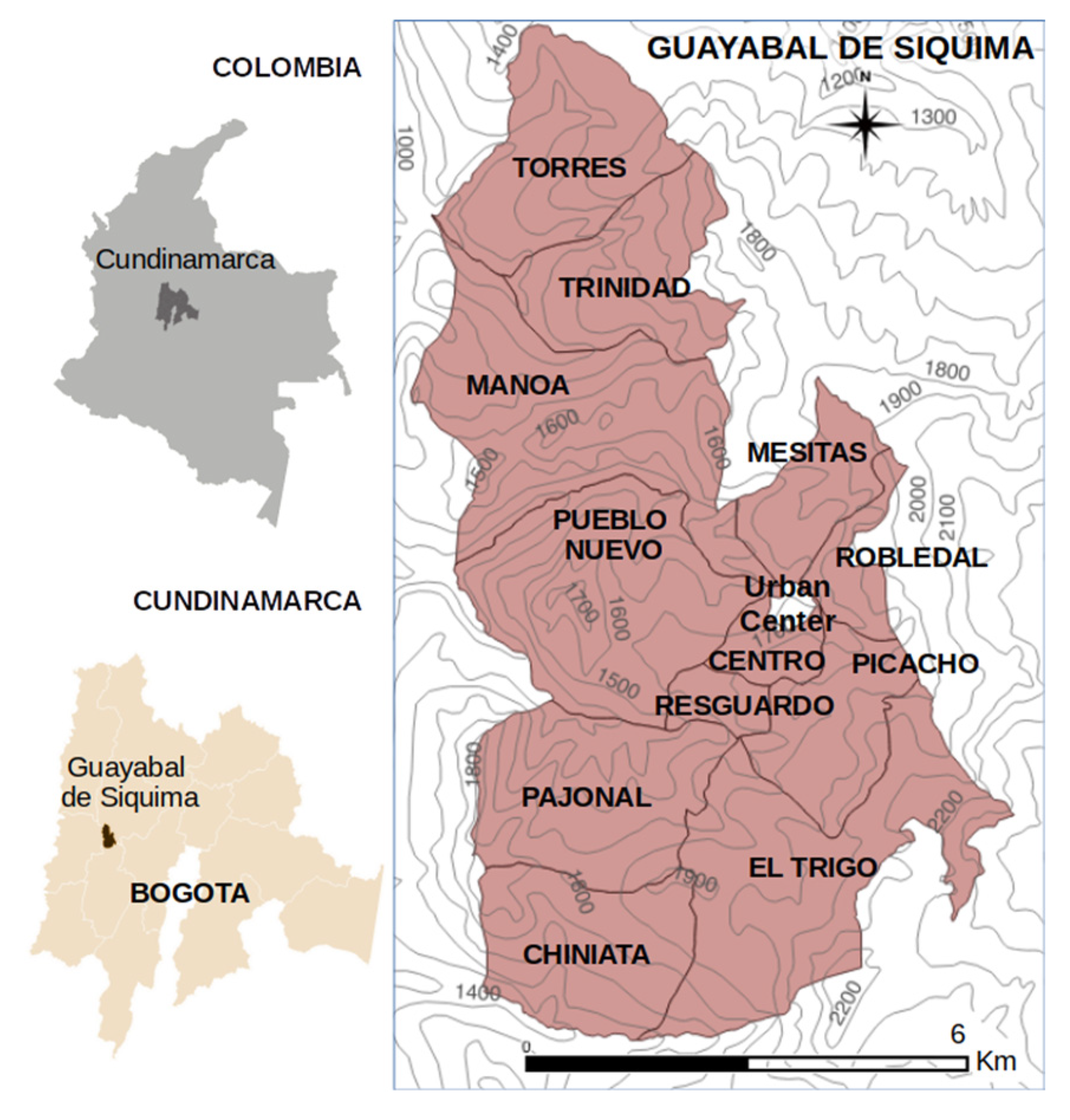
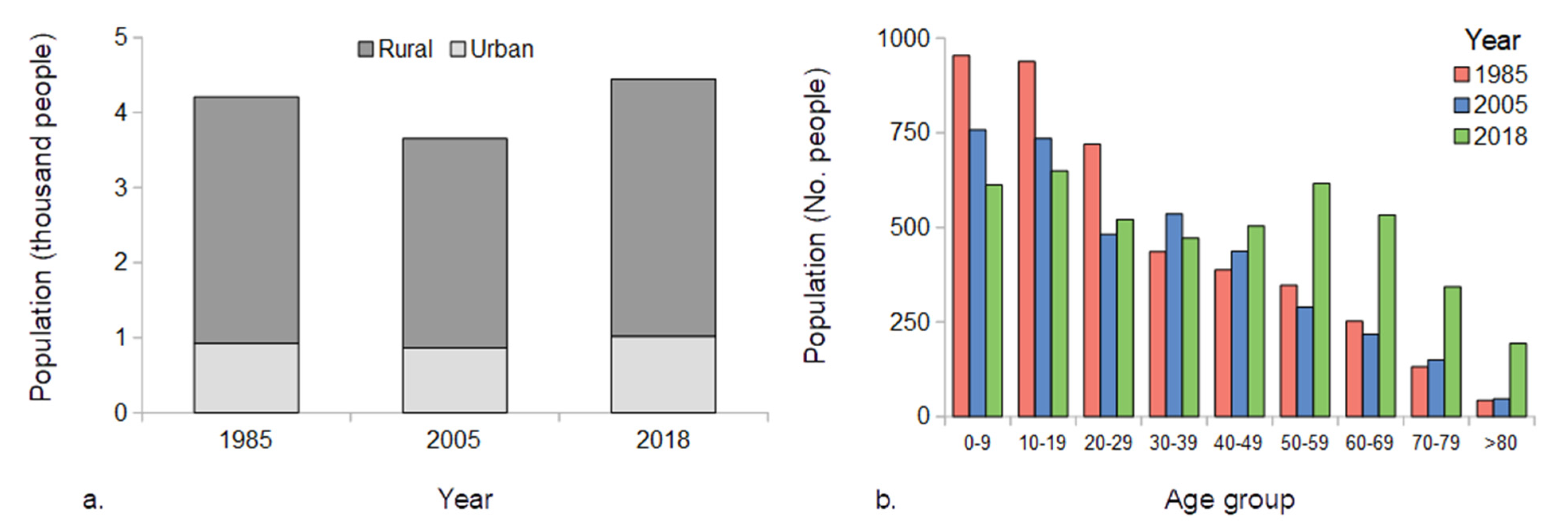
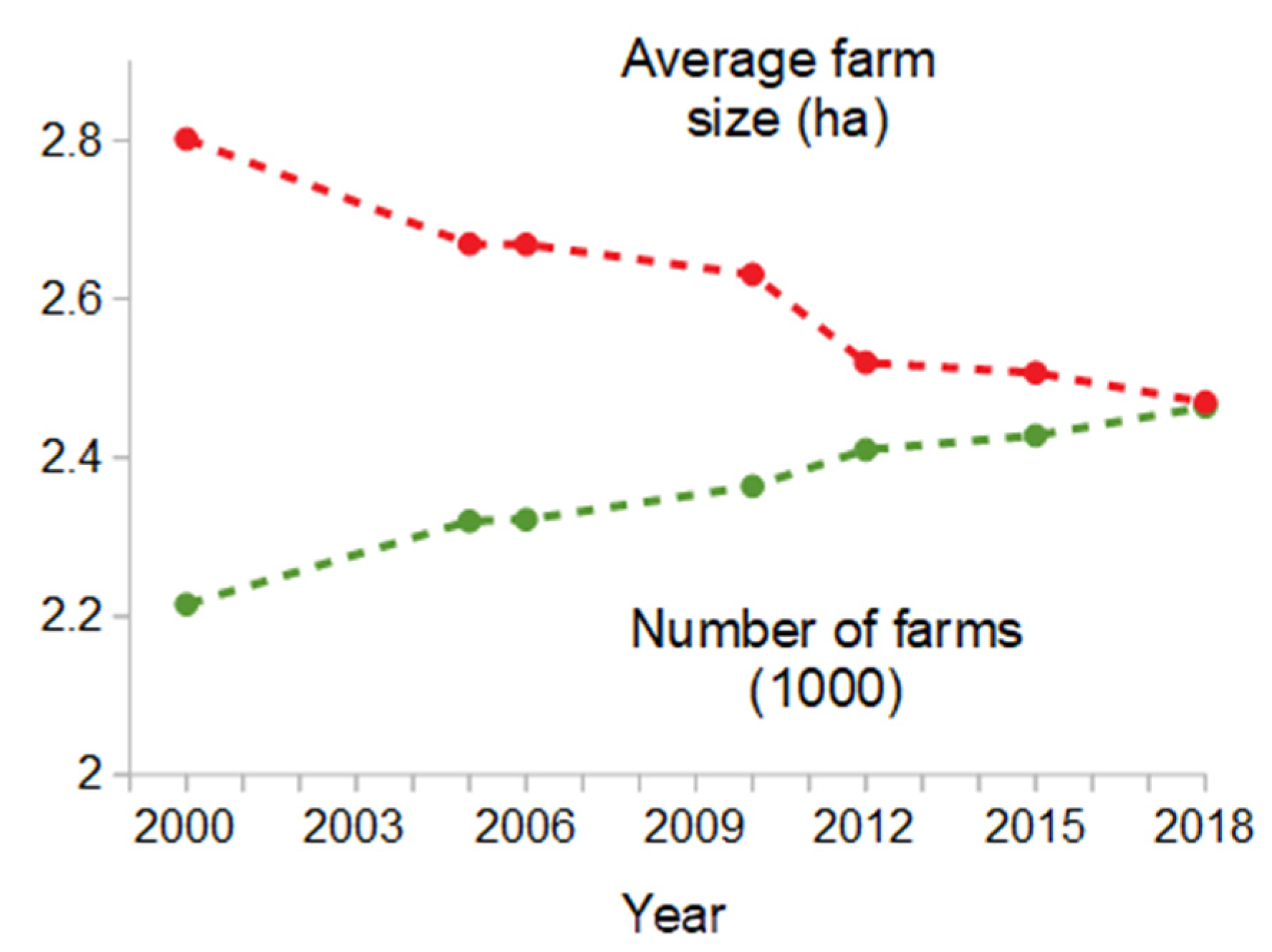
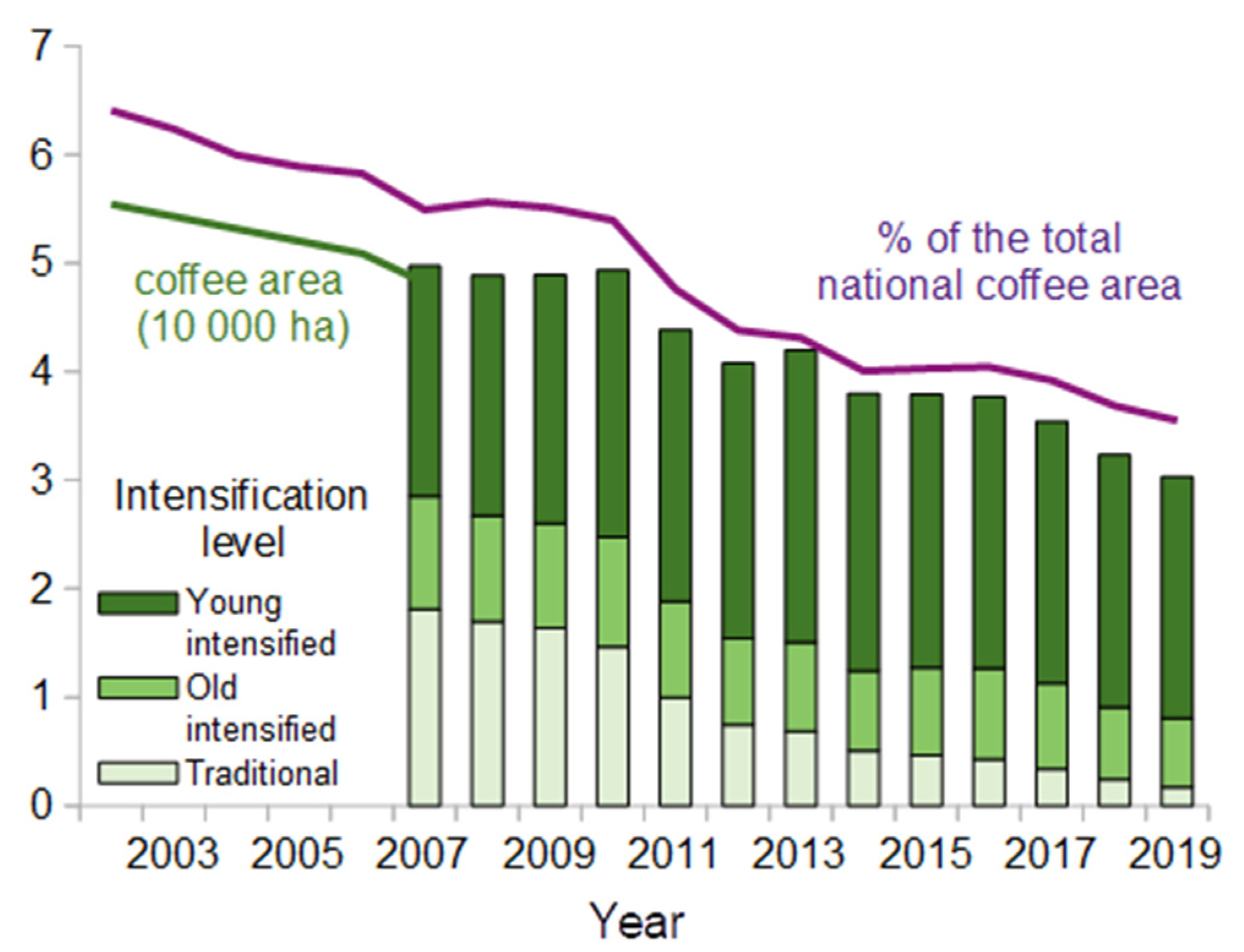
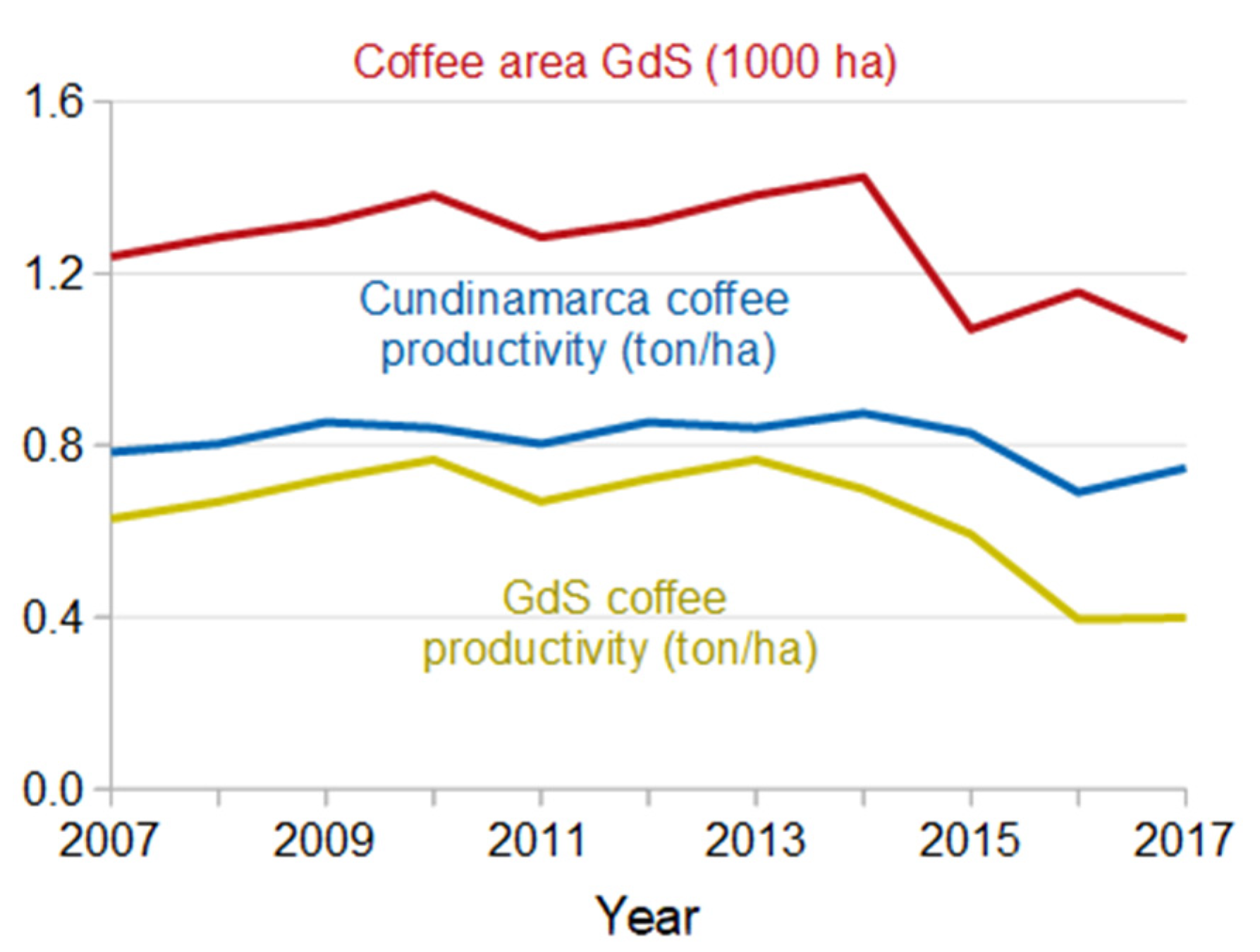
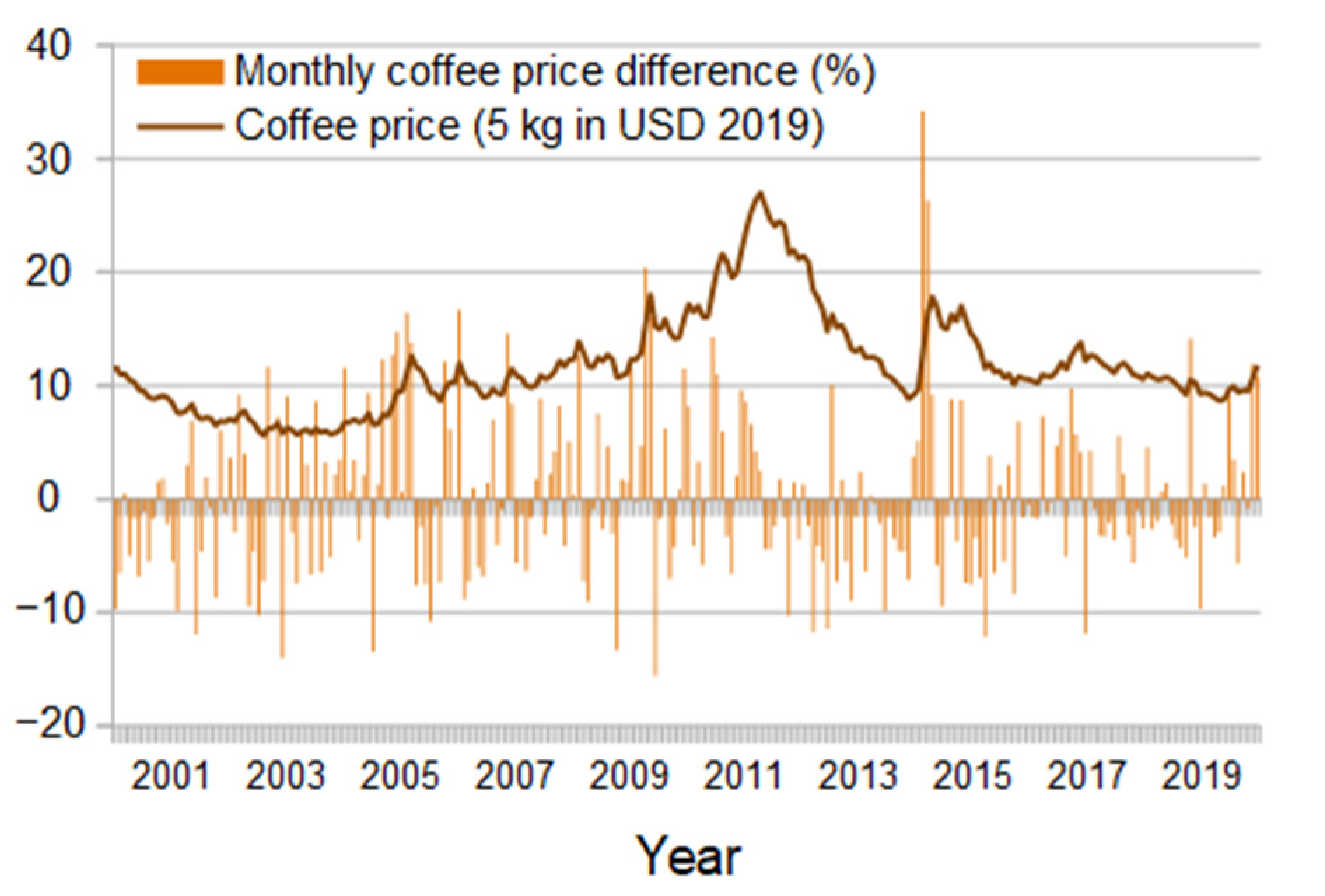
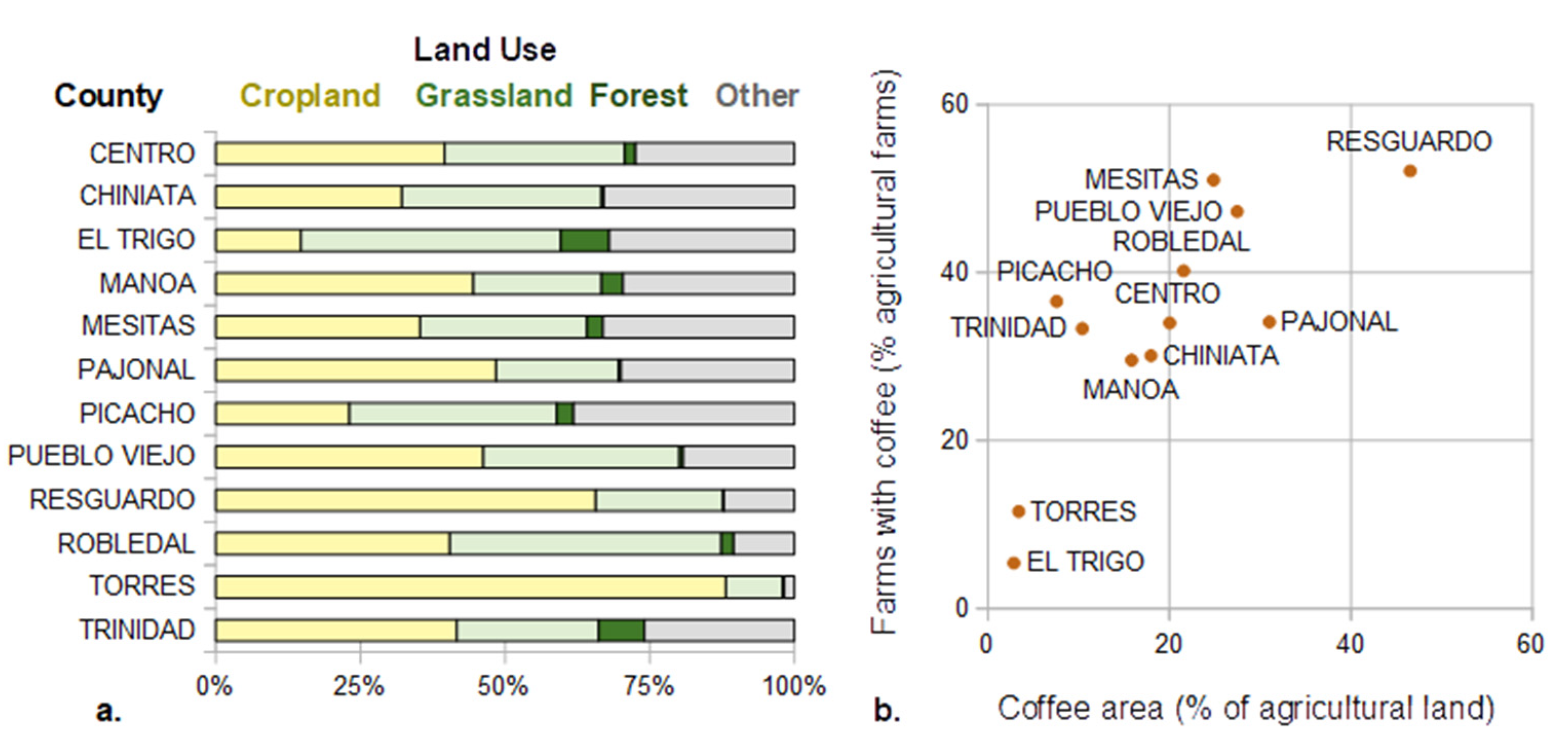
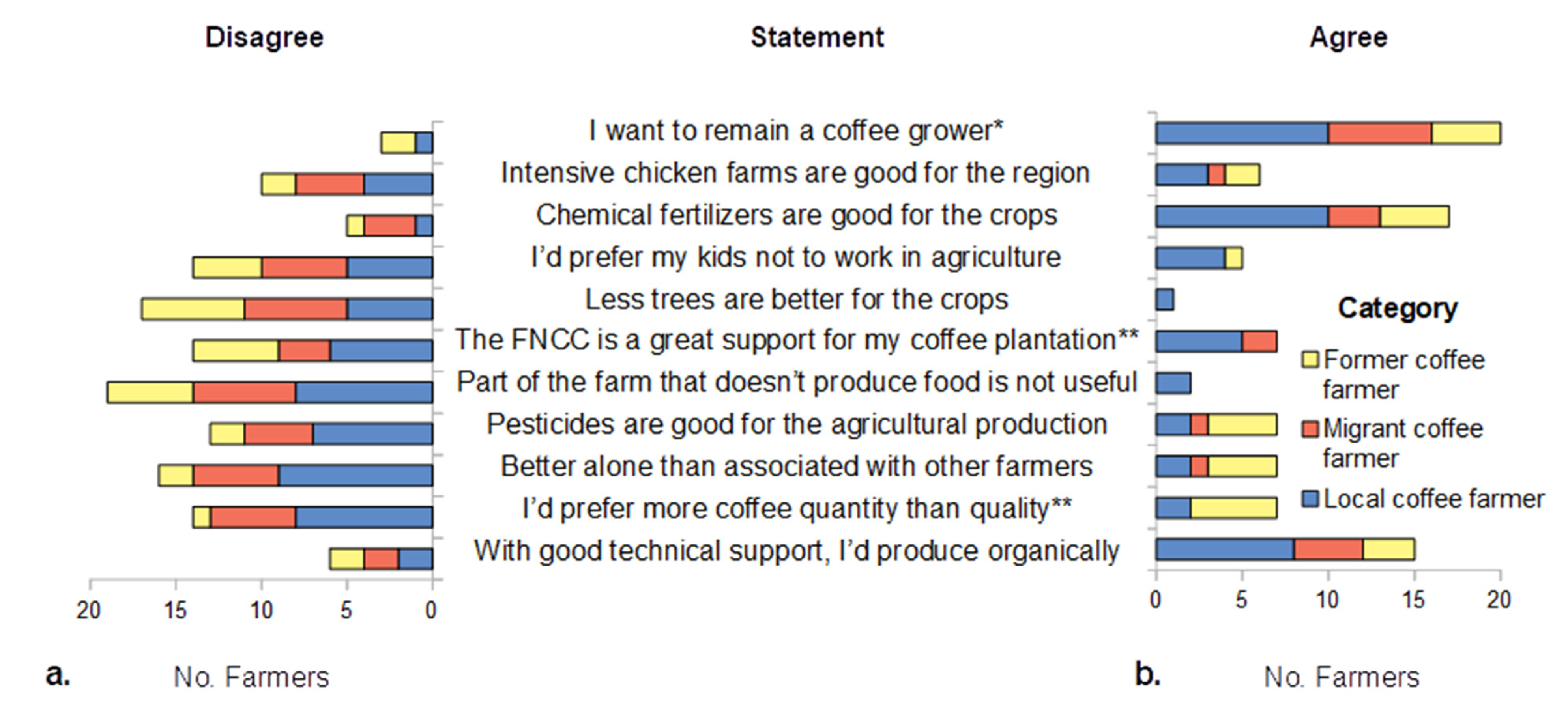
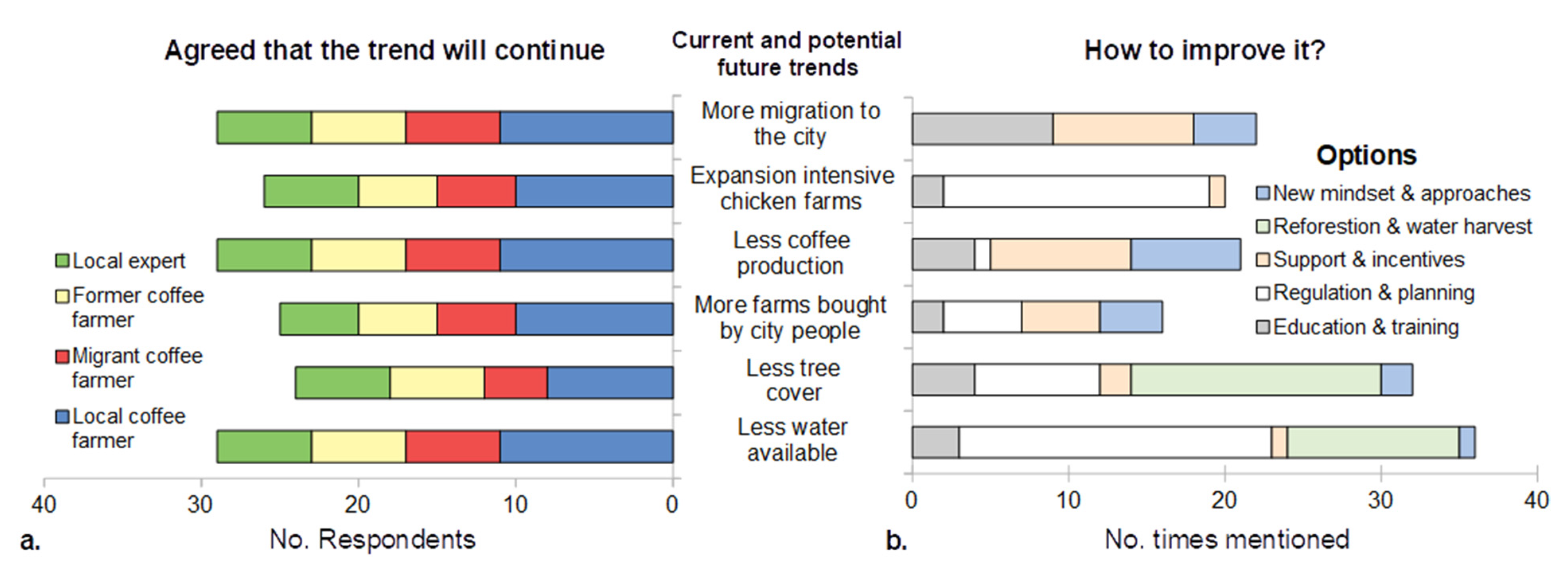
| Village | Reported Area * | Share of Tot. Area ** | Agric. Area *** | Farms | Agric. Farms *** | Farms < 2 ha | Chicken Farms | Cattle Herd | Cattle Density |
|---|---|---|---|---|---|---|---|---|---|
| % | % | % | No. | % | % | No. | No. | No./ha GRASSLAND | |
| Centro | 100 | 2 | 79 | 178 | 56 | 90 | 2 | 28 | 0.91 |
| Chiniata | 89 | 10 | 99 | 199 | 93 | 55 | 1 | 294 | 1.78 |
| El Trigo | 73 | 14 | 98 | 236 | 94 | 50 | 0 | 666 | 2.14 |
| Manoa | 76 | 15 | 80 | 154 | 75 | 39 | 4 | 99 | 0.76 |
| Mesitas | 77 | 4 | 79 | 297 | 49 | 83 | 11 | 172 | 3.64 |
| Pajonal | 87 | 11 | 98 | 183 | 93 | 48 | 1 | 308 | 2.63 |
| Picacho | 95 | 7 | 94 | 110 | 75 | 62 | 0 | 281 | 2.36 |
| Pueblo Viejo | 94 | 16 | 90 | 340 | 70 | 64 | 6 | 195 | 0.80 |
| Resguardo | 97 | 2 | 83 | 112 | 63 | 83 | 0 | 9 | 0.50 |
| Robledal | 86 | 2 | 93 | 138 | 67 | 84 | 2 | 116 | 2.18 |
| Torres | 88 | 11 | 96 | 133 | 91 | 59 | 1 | 6 | 0.12 |
| Trinidad | 43 | 4 | 93 | 98 | 83 | 69 | 5 | 69 | 1.44 |
| Total | 81 | 98 | 91 | 2178 | 75 | 63 | 33 | 2243 | 1.68 |
| Village | Coffee Farmers | Farmers > 60 yrs * | Farms < 2 ha | Fam Labour > 50% | Coffee > 75% Area | Coffee Associated | Chickens | Pork and Cattle | Drought Problems |
|---|---|---|---|---|---|---|---|---|---|
| No. | % | % | % | % | % | % | % | % | |
| Centro | 32 | 58 | 88 | 53 | 63 | 72 | 13 | 16 | 13 |
| Chiniata | 56 | 19 | 63 | 46 | 80 | 93 | 5 | 20 | 36 |
| El Trigo | 12 | 67 | 42 | 50 | 75 | 100 | 42 | 42 | 17 |
| Manoa | 34 | 57 | 44 | 15 | 91 | 91 | 18 | 18 | 35 |
| Mesitas | 72 | 46 | 89 | 65 | 76 | 58 | 14 | 17 | 28 |
| Pajonal | 57 | 34 | 39 | 44 | 61 | 68 | 18 | 32 | 40 |
| Picacho | 29 | 64 | 76 | 45 | 83 | 76 | 14 | 28 | 38 |
| Pueblo Viejo | 113 | 46 | 66 | 42 | 81 | 76 | 19 | 14 | 48 |
| Resguardo | 37 | 44 | 78 | 51 | 89 | 81 | 5 | 11 | 43 |
| Robledal | 37 | 67 | 86 | 62 | 78 | 73 | 8 | 5 | 35 |
| Torres | 14 | 14 | 57 | 7 | 50 | 93 | 14 | 0 | 14 |
| Trinidad | 26 | 64 | 73 | 62 | 73 | 96 | 31 | 35 | 38 |
| Total | 519 | 47 | 68 | 47 | 77 | 77 | 15 | 18 | 36 |
| Variable | Unit | Categories | ||
|---|---|---|---|---|
| Local Coffee Farmers | Migrant Coffee Farmers | Former Coffee Farmers | ||
| Interviewees | No. | 11 | 6 | 6 |
| More than 60 years old | % | 55 | 50 | 33 |
| Household members | people | 2.3 ± 0.8 | 2.8 ± 1.5 | 2.7 ± 1.2 |
| Farm size | ha | 3.1 ± 1.3 | 3.5 ± 1.8 | 4.4 ± 2.7 * |
| With off-farm income | % | 46 | 100 | 83 |
| Amount of food produced on farm | % | 40 | 24 | 36 * |
| Purchasing goods in city | % | 90 | 100 | n.a. |
| Poultry production | % | 55 | 83 | 83 |
| Technical support | % | 27 | 17 | n.a. |
| Member of the FNCC | % | 73 | 33 | n.a. |
| Coffee area | % area | 64 ± 28 | 49 ± 22 | 50 ± 28 |
| Coffee income | % income | 37 ± 30 | 18 ± 10 | n.a. |
| Organic production | % | 18 | 50 | n.a. |
| Improved varieties | % | 90 | 67 | n.a. |
| Shaded coffee | % area | 79 ± 34 | 58 ± 49 | n.a. |
| Direct coffee selling | % | 45 | 50 | n.a. |
| Part unprocessed selling | % | 36 | 33 | n.a. |
Publisher’s Note: MDPI stays neutral with regard to jurisdictional claims in published maps and institutional affiliations. |
© 2021 by the authors. Licensee MDPI, Basel, Switzerland. This article is an open access article distributed under the terms and conditions of the Creative Commons Attribution (CC BY) license (https://creativecommons.org/licenses/by/4.0/).
Share and Cite
Valbuena, D.; Chenet, J.G.; Gaitán-Cremaschi, D. Options to Support Sustainable Trajectories in a Rural Landscape: Drivers, Rural Processes, and Local Perceptions in a Colombian Coffee-Growing Region. Sustainability 2021, 13, 13026. https://doi.org/10.3390/su132313026
Valbuena D, Chenet JG, Gaitán-Cremaschi D. Options to Support Sustainable Trajectories in a Rural Landscape: Drivers, Rural Processes, and Local Perceptions in a Colombian Coffee-Growing Region. Sustainability. 2021; 13(23):13026. https://doi.org/10.3390/su132313026
Chicago/Turabian StyleValbuena, Diego, Julien G. Chenet, and Daniel Gaitán-Cremaschi. 2021. "Options to Support Sustainable Trajectories in a Rural Landscape: Drivers, Rural Processes, and Local Perceptions in a Colombian Coffee-Growing Region" Sustainability 13, no. 23: 13026. https://doi.org/10.3390/su132313026
APA StyleValbuena, D., Chenet, J. G., & Gaitán-Cremaschi, D. (2021). Options to Support Sustainable Trajectories in a Rural Landscape: Drivers, Rural Processes, and Local Perceptions in a Colombian Coffee-Growing Region. Sustainability, 13(23), 13026. https://doi.org/10.3390/su132313026





